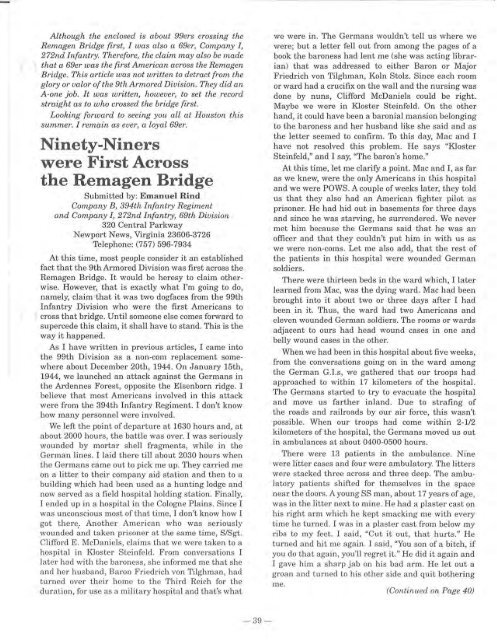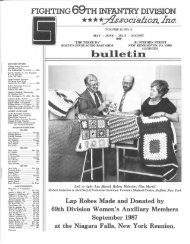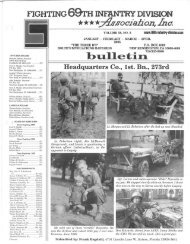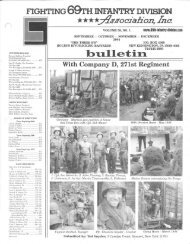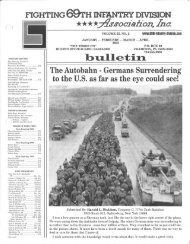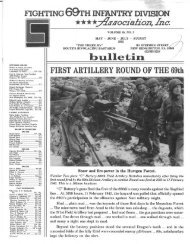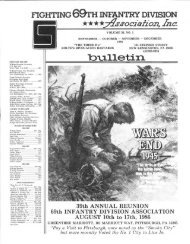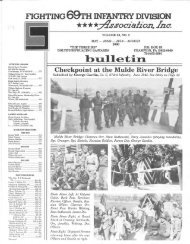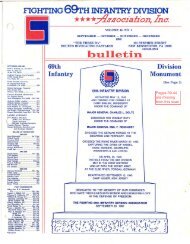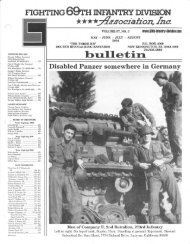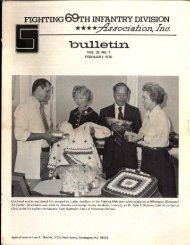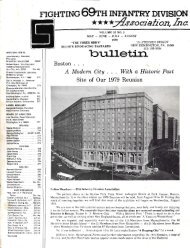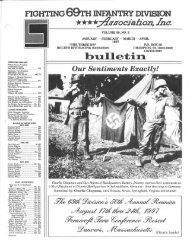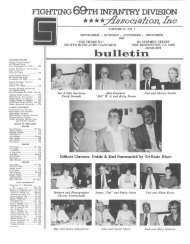Fred Scherer is now 86 years old but - The Fighting 69th Infantry ...
Fred Scherer is now 86 years old but - The Fighting 69th Infantry ...
Fred Scherer is now 86 years old but - The Fighting 69th Infantry ...
You also want an ePaper? Increase the reach of your titles
YUMPU automatically turns print PDFs into web optimized ePapers that Google loves.
Although the enclosed <strong>is</strong> about 9gers crossing the<br />
Remagen Bridge first, I was also a 6ger, Company I,<br />
272nd <strong>Infantry</strong>. <strong>The</strong>refore, the claim may also be made<br />
that a 6ger was the first American across the Remagen<br />
Bridge. Th<strong>is</strong> article was not written to detract from the<br />
glory or valor of the 9th Armored Div<strong>is</strong>ion. <strong>The</strong>y did an<br />
A-one job. It was written, however, to set the record<br />
straight as to who crossed the bridge first.<br />
Looking forward to seeing you all at Houston th<strong>is</strong><br />
summer. I remain as ever, a loyal 6ger.<br />
Ninety-Niners<br />
were First Across<br />
the Remagen Bridge<br />
Submitted by: Emanuel Rind<br />
Company B, 394th <strong>Infantry</strong> Regiment<br />
and Company I, 272nd <strong>Infantry</strong>, <strong>69th</strong> Div<strong>is</strong>ion<br />
320 Central Parkway<br />
Newport News, Virginia 23606-3726<br />
Telephone: (757) 596-7934<br />
At th<strong>is</strong> time, most people consider it an establ<strong>is</strong>hed<br />
fact that the 9th Armored Div<strong>is</strong>ion was first across the<br />
Remagen Bridge. It would be heresy to claim otherw<strong>is</strong>e.<br />
However, that <strong>is</strong> exactly what I'm going to do,<br />
namely, claim that it was two dogfaces from the 99th<br />
<strong>Infantry</strong> Div<strong>is</strong>ion who were the first Americans to<br />
cross that bridge. Until someone else comes forward to<br />
supercede th<strong>is</strong> claim, it shall have to stand. Th<strong>is</strong> <strong>is</strong> the<br />
way it happened.<br />
As I have written in previous articles, I came into<br />
the 99th Div<strong>is</strong>ion as a non-com replacement somewhere<br />
about December 20th, 1944. On January 15th,<br />
1944, we launched an attack against the Germans in<br />
the Ardennes Forest, opposite the Elsenborn ridge. I<br />
believe that most Americans involved in th<strong>is</strong> attack<br />
were from the 394th <strong>Infantry</strong> Regiment. I don't k<strong>now</strong><br />
how many personnel were involved.<br />
We left the point of departure at 1630 hours and, at<br />
about 2000 hours, the battle was over. I was seriously<br />
wounded by mortar shell fragments, while in the<br />
German lines. I laid there till about 2030 hours when<br />
the Germans came out to pick me up. <strong>The</strong>y carried me<br />
on a litter to their company aid station and then to a<br />
building which had been used as a hunting lodge and<br />
<strong>now</strong> served as a field hospital h<strong>old</strong>ing station. Finally,<br />
I ended up in a hospital in the Cologne Plains. Since I<br />
was unconscious most of that time, I don't k<strong>now</strong> how I<br />
got there.. Another American who was seriously<br />
wounded and taken pr<strong>is</strong>oner at the same time, S/Sgt.<br />
Clifford E. McDaniels, claims that we were taken to a<br />
hospital in Kloster Steinfeld. From conversations I<br />
later ha d with the baroness, she informed me that she<br />
and her husband, Baron Friedrich von Tilghman, had<br />
turned over their home to the Third Reich for the<br />
duration, for use as a military hospital and that's what<br />
-39-<br />
we were in. <strong>The</strong> Germans wouldn't tell us where we<br />
were; <strong>but</strong> a letter fell out from among the pages of a<br />
book the baroness had lent me (she was acting librarian)<br />
that was addressed to either Baron or Major<br />
Friedrich von Tilghman, Koln Stolz. Since each room<br />
or ward had a crucifix on the wall and the nursing was<br />
done by nuns, Clifford McDaniels could be right.<br />
Maybe we were in Kloster Steinfeld. On the other<br />
hand, it could have been a baronial mansion belonging<br />
to the baroness and her husband like she said and as<br />
the letter seemed to confirm. To th<strong>is</strong> day, Mac and I<br />
have not resolved th<strong>is</strong> problem. He says "Kloster<br />
Steinfeld," and I say, "<strong>The</strong> baron's home."<br />
At th<strong>is</strong> time, let me clarify a point. Mac and I, as far<br />
as we knew, were the only Americans in th<strong>is</strong> hospital<br />
and we were POWS. A couple of weeks later, they t<strong>old</strong><br />
us that they also had an American fighter pilot as<br />
pr<strong>is</strong>oner. He had hid out in basements for three days<br />
and since he was starving, he surrendered. We never<br />
met him because the Germans said that he was an<br />
officer and that they couldn't put him in with us as<br />
we were non-corns. Let me also add, that the rest of<br />
the patients in th<strong>is</strong> hospital were wounded German<br />
s<strong>old</strong>iers.<br />
<strong>The</strong>re were thirteen beds in the ward which, I later<br />
learned from Mac, was the dying ward. Mac had been<br />
brought into it about two or three days after I had<br />
been in it. Thus, the ward had two Americans and<br />
eleven wounded German s<strong>old</strong>iers. <strong>The</strong> rooms or wards<br />
adjacent to ours had head wound cases in one and<br />
belly wound cases in the other.<br />
When we had been in th<strong>is</strong> hospital about five weeks,<br />
from the conversations going on in the ward among<br />
the German G.I.s, we gathered that our troops had<br />
approached to within 17 kilometers of the hospital.<br />
<strong>The</strong> Germans started to try to evacuate the hospital<br />
and move us farther inland. Due to strafing of<br />
the roads and railroads by our air force, th<strong>is</strong> wasn't<br />
possible. When our troops had come within 2-1/2<br />
kilometers of the hospital, the Germans moved us out<br />
in ambulances at about 0400-0500 hours.<br />
<strong>The</strong>re were 13 patients in the ambulance. Nine<br />
were litter cases and four were ambulatory. <strong>The</strong> litters<br />
were stacked three across and three deep. <strong>The</strong> ambulatory<br />
patients shifted for themselves in the space<br />
near the doors. Ayoung SS man, about 17 <strong>years</strong> of age,<br />
was in the litter next to mine. He had a plaster cast on<br />
h<strong>is</strong> right arm which he kept smacking me with every<br />
time he turned. I was in a plaster cast from below my<br />
ribs to my feet. I said, "Cut it out, that hurts." He<br />
turned and hit me again. I said, "You son of a bitch, if<br />
you do that again, you'll regret it." He did it again and<br />
I gave him a sharp jab on h<strong>is</strong> bad arm. He let out a<br />
groan and turned to h<strong>is</strong> other side and quit bothering<br />
me.<br />
(Continued on Page 40)


